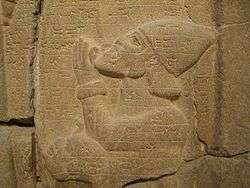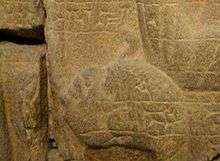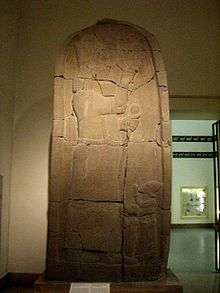Victory stele of Esarhaddon
|
The Victory Stele in its current location. | |
| Material | Dolerite |
|---|---|
| Size | 3.46m x 1.35m |
| Writing | Akkadian Cuneiform |
| Created | c. 670 BC |
| Discovered | 1888 |
| Present location | Pergamon Museum |
| Identification | VA2708 |

The Victory stele of Esarhaddon is a dolerite[1] stele commemorating the return of Esarhaddon after his army's 2nd battle and victory over Pharaoh Taharqa in northern ancient Egypt in 671 BC. It was discovered in 1888 in Zincirli Höyük (Sam'al, or Yadiya) by Felix von Luschan and Robert Koldewey. It is now in the Pergamon Museum in Berlin.
The prior battle of 674 BC was won by Taharqa after confronting Esarhaddon after his initial foray into the Levant;[2] Esarhaddon then entered northern Egypt but was repulsed by Taharqa's forces.
The second battle of 671 BC saw Taharqa retreat with his army to Memphis; Memphis was taken with Taharqa then fleeing to Kush. With Esarhaddon's victory he: "slaughtered the villagers and 'erected piles of their heads', "[3] As Esarhaddon wrote later:
- "His queen, his harem, [Prince] Ushankhuru his heir, and the rest of his sons and daughters, his property and his goods, his horses, his cattle, his sheep in countless numbers, I carried off to Assyria. The root of Kush I tore up out of Egypt."[3]
Description

The stele shows Esarhaddon standing on the left in an honorific pose. He is holding a mace club in his left hand, arm at his side. His right hand is addressing the gods. Cuneiform script covers the entire medium bas relief scene.
The attendant before him may be Baal I, mentioned in Esarhaddon's Treaty with Ba'al of Tyre. Between the two kneeling is prince Ushankhuru with a rope tied around his neck.
Editio princeps
References
- ↑ Verzeichnis der in der Formerei der Königl. Museen käuflichen Gipsabgüsse (1902) page 20
- ↑ Black Pharaohs, National Geographic Magazine, February, 2008, p. 58.
- 1 2 Black Pharaohs, p. 58.
